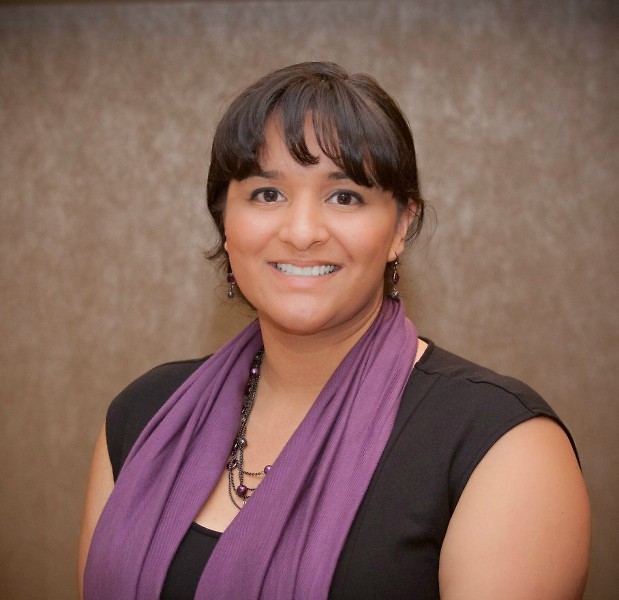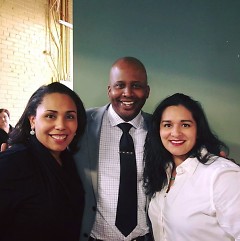Stacy Stout was hired by the City of Grand Rapids in January, 2016 to be an Assistant to the City Manager, specifically appointed to coordinate efforts to implement the anti-violence recommendations of the SAFE Report released in March 2015 and to be a liaison between the City and its neighborhoods, building their capacity.
“It was explicitly written in the SAFE Report to have someone with access to the Mayor and City Manager to keep anti-violence strategies at the forefront at City Hall,” notes Stout. “When I applied to the job it was posted as “Assistant to the City Manager-Neighborhood Coordinator. But I don’t feel like Neighborhood Coordinator is true to what I do because I don’t coordinate the neighborhoods. What I do is support the city’s role in neighborhood initiatives.”
Stout formerly worked as a program manager at the W.K. Kellogg Foundation and is the co-founder of the Latina Network of West Michigan. She has a Master’s degree in Non-profit Management and Leadership from Grand Valley State University and a Bachelor’s degree in Biology from GVSU.
“I’m excited to work at the City. I know there’s criticism of City Hall and I understand that, but the folks that I’m around seem very open to learning and improving and updating their information so that they can do better. I was my authentic self in all the interviews. I was very clear I was coming with this racial equity lens, this is very important to me, it’s who I am,” says Stout who identifies as Latina and Indigenous. “It’s not going to get toned down when I start-is everyone ready, you know? Because I was interviewing them too. And they were just so supportive and excited.”
Stout says she's tasked to help grow the strength of the neighborhoods in the City, particularly those who've been historically marginalized.
"One of the recommendations out of the summit was to have a targeted approach of increasing the capacity of neighborhoods, sometimes that’s going to be through the neighborhood association, but some geographic areas don’t have neighborhood associations. And we really want to focus on the most vulnerable and marginalized, so how do we support them in a different way? How do they want to be supported? We have a lot of great organizations in those areas, so they may want to step in more. But it’s really a community conversation that we have to have and I’ll follow their lead," says Stout.
Currently, Stout meets with the neighborhood associations almost monthly to check in on their concerns, have peer-to-peer trainings, bring in city leaders for updates, and strategize on how to get things done together.
"And I’m in awe of all the activities and events that they do. There’s a lot of coordination happening at these meetings. It’s really nice to all get together and instead of trying over three different emails to just get know each other and knock it out. I really enjoy it."
Stout notes that a consistent theme when she was first hired was to focus on structural change and not just programming.
"One of the value streams in the transformation plan is for me to work with Parks and Rec to increase activity in the neighborhoods in the parks. The feedback from the community was, “We need jobs.” How do we hire local to build these parks and maintain these parks? With the income disparities, again that was from the Neighborhood Summit, what are we going to do to address the racialized income disparities? As a Grand Rapids taxpayer, hire more neighbors! I want everyone to have income."
Stout adds that this need for jobs doesn't take away from the importance of parks.
"I felt the wellness in me when I moved from an area that was park-deprived and I moved near Richmond Park and now near Blandford. I grew up in Whitehall, north of Muskegon. It’s a little bit more country. I didn’t realize how much stress I was under until I moved and I had green space. It’s just amazing. I live and work in the city and it think it’s important to figure out how to incentivize more of that for everyone."
When asked about the statistic from DGRI's study that showed 90% of people who work downtown are white, Stout responded, “I didn't know that statistic, but you can feel it. I remember my husband, who is not white, came and visited me downtown at my other job. People wouldn’t look at him, he’d say hello and people would not acknowledge him. He’s just like this nice guy and it can be really tense down here.”
Stout emphasizes the racial equity lens she's bringing to this job.
"So, I’m not over housing, but I can support the city on their approach to talking about it, to building it, to working with community, because several departments, engage community, but what does that engagement mean? I really want us to get away from checking the box. I want more co-ownership."
Stout notes that it’s a mental model of community engagement viewing residents not as customers, but partners.
“I view them as my boss, actually. They’re citizens to serve, but what does that mean, really? I’m here to serve through a racial equity lens. So, who is the most vulnerable? Who has systematically been marginalized? And how do we lift them up so that we have a more equitable Grand Rapids?
And then also look internally. “Lift them up” is external, but what are we, the City, going to do internally to structure in a way that it automatically happens?
For example, Stout wants to work with the City’s Office of Diversity and Inclusion and the Clerk’s Office and various community groups on how leadership and decision making can be shared with residents. Looking for ways to operationalize equitable pipelines which result in diverse boards and commissions with more city residents that reflect the community is a large part of those goals.
“And some people might say, “They don’t know about planning.” But they know about their community and they can learn about other stuff. And when you talk about planning, you always have to ask about for whom? Planning for whom? Housing for whom?”
Stout also notes that leveraging the momentum, passions and skills of networks and partners in the community like GGRREN, the Hispanic Center, the Urban League, LINC will be important to get citizens in the pipelines for leadership and decision making.
“You want fairness, you know? You want everyone to have opportunities, and if they don’t, they have to say it. I feel like there’s going to be a lot of allies come out of the woodwork, I’m hopeful. Don’t get me wrong, I’m a person of color who’s been up against oppression my whole life, so I know there will be other people that come out of the woodwork against it, but I have to believe in Grand Rapids. And not just the City Hall, but the community that will back this up and push for it.”
Stout says that Mayor Bliss noting the large racial disparities in Grand Rapids during her State of the City is an explicit commitment from the City.
“So it’s a good opportunity right now because the community is getting more vocal about wanting equity. Not just vocal, but demanding some action steps, calling folks out. And I always feel like if I’m not doing all that I can do build equity, to push for equity and for community, if I’m not doing it, well then I’m a part of the oppression. So, I can’t be a part of the oppression of my people.”
Stout acknowledges this is a long-term game, but insists Grand Rapids keeps pushing for change.
“We have to stop with the West Michigan nice. We have to stop being afraid of conflict and embrace it and have difficult conversations. My value add will be was “Was it operationalized? Did we do it in a different way? Did we work with developers in a different way that was more community oriented? Are there more residents that actually live in the city on these boards and commissions making decisions? I really believe that if we have more GR residents with an equity lens and some training, things will be different."
The Rapidian, a program of the 501(c)3 nonprofit Community Media Center, relies on the community’s support to help cover the cost of training reporters and publishing content.
We need your help.
If each of our readers and content creators who values this community platform help support its creation and maintenance, The Rapidian can continue to educate and facilitate a conversation around issues for years to come.
Please support The Rapidian and make a contribution today.


